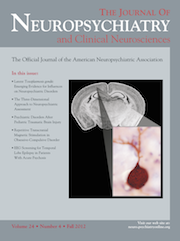Status Epilepticus Associated With Dalfampridine in a Patient With Multiple Sclerosis
To the Editor: We present a patient with multiple sclerosis (MS) who developed status epilepticus associated with dalfampridine and cocaine abuse. This case highlights the importance of remaining vigilant about this potential complication in this patient population, especially when there is a history of drug abuse.
Dalfampridine is a time-release formulation of 4-aminopyridine, a voltage-gated potassium channel-blocker that improves nerve conduction in demyelinated fibers, but may also increase neuronal excitability and neurotransmitter release.1 It is used to improve walking speed in MS patients.2 A potential side effect of this is lowering of the seizure threshold in a dose-dependent fashion. We report a patient with MS treated with dalfampridine who presented with status epilepticus after using cocaine.
Case Description
A 49-year-old, right-handed man was diagnosed with relapsing-remitting MS in 2005. The diagnosis of MS was established by clinical, MRI, and CSF criteria. He was being treated with natalizumab since 2008. Eight months before admission, dalfampridine had been introduced, and he responded with improved walking speed. In June 2011, he was brought to the emergency department after his roommate witnessed several generalized tonic–clonic seizures. His outpatient medications included dalfampridine, natalizumab, morphine sulfate, and tizanidine. He had no previous history of seizures, CNS infections, head trauma, or renal insufficiency. There was no family history of epilepsy. He had a remote history of cocaine abuse 5 years earlier.
The status epilepticus was initially treated with lorazepam and fosphenytoin; but the seizures persisted, requiring that the patient be intubated for airway protection and placed on a propofol infusion, which led to clinical and electrographic cessation of seizures. Phenytoin was started for maintenance, and dalfampridine was withdrawn. MRI of the brain with gadolinium revealed extensive periventricular and juxtacortical white-matter lesions, but no new T2 hyperintense lesions or contrast-enhancing lesions. Serology including electrolytes and creatinine was within normal limits. Cerebrospinal fluid was also normal, and PCR for the JC virus was not detected.
Urine toxicology was positive for cocaine and cannabis, and the patient admitted to smoking marijuana laced with crack cocaine before presentation. Two consecutive EEGs showed bilateral fronto-central sharp waves within a disorganized background, so antiepileptic drug therapy was switched to levetiracetam. He was discharged to a rehabilitation facility. Two months after discharge a repeat EEG did not show epileptiform activity. He complained of irritability on the levetiracetam, so he was switched to lamotrigine. Six months later, he remains seizure-free and has continued to abstain from cocaine use.
Discussion
This patient presented with status epilepticus in the setting of long-standing MS, treatment with natalizumab and dalfampridine, and recent use of cocaine. Epidemiological studies have shown that seizures are more frequent in MS patients than in the general population, with estimated prevalences of 2.33%–4.25%.3 Seizures may occur at any point during the course of the disease, and there is no specific EEG pattern that predicts their occurrence.3
In this patient, status epilepticus during treatment with dalfampridine was most likely multifactorial. This patient’s absence of new lesions on MRI and normal CSF, including JC virus PCR, excluded an infectious process. Dalfampridine at 10 mg bid has an incidence of seizures of 0.4/100 person-years, which is similar to background rates of first seizure of approximately 0.35/ 100 patient-years.4 Higher doses and renal insufficiency increase these rates. This patient was taking the recommended dose and had normal renal function; however, his multiple risk factors for seizures, including MS and recent cocaine abuse, lowered his seizure threshold. This case highlights the risk of status epilepticus with dalfampridine in MS patients who use cocaine and underscores the importance of clinicians to be vigilant about this potential side effect, especially in patients with a history of drug abuse.
1 : Dalfampridine Sustained-Release for symptomatic improvement of walking speed in patients with multiple sclerosis. Core Evid 2010; 5:107–112; Dove Press; available at http://www.dovepress.com/core-evidence-journalCrossref, Medline, Google Scholar
2 ,
3 : Epileptic seizures in multiple sclerosis: clinical and EEG correlations. Neurol Sci 2003; 24:322–328Crossref, Medline, Google Scholar
4 ,



